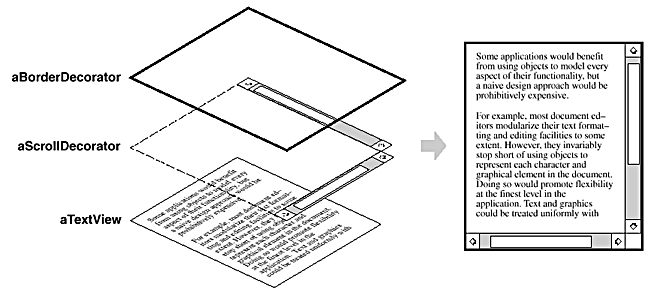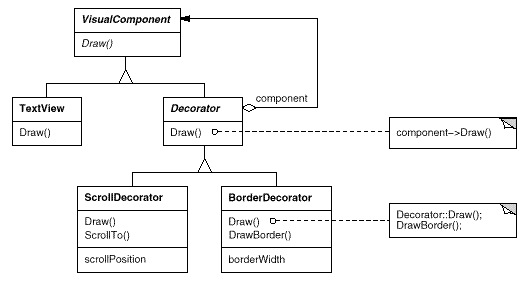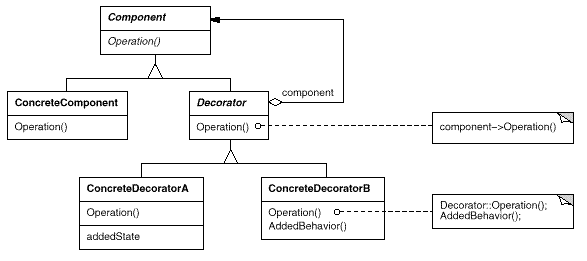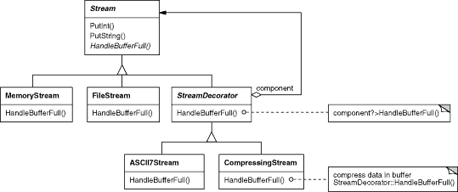 Intent
Intent Intent
IntentAttach additional responsibilities to an object dynamically. Decorators provide a flexible alternative to subclassing for extending functionality.
 Also Known As
Also Known AsWrapper
 Motivation
MotivationSometimes we want to add responsibilities to individual objects, not to an entire class. A graphical user interface toolkit, for example, should let you add properties like borders or behaviors like scrolling to any user interface component.
One way to add responsibilities is with inheritance. Inheriting a border from another class puts a border around every subclass instance. This is inflexible, however, because the choice of border is made statically. A client can't control how and when to decorate the component with a border.
A more flexible approach is to enclose the component in another object that adds the border. The enclosing object is called a decorator. The decorator conforms to the interface of the component it decorates so that its presence is transparent to the component's clients. The decorator forwards requests to the component and may perform additional actions (such as drawing a border) before or after forwarding. Transparency lets you nest decorators recursively, thereby allowing an unlimited number of added responsibilities.

For example, suppose we have a TextView object that displays text in a window. TextView has no scroll bars by default, because we might not always need them. When we do, we can use a ScrollDecorator to add them. Suppose we also want to add a thick black border around the TextView. We can use a BorderDecorator to add this as well. We simply compose the decorators with the TextView to produce the desired result.
The following object diagram shows how to compose a TextView object with BorderDecorator and ScrollDecorator objects to produce a bordered, scrollable text view:

The ScrollDecorator and BorderDecorator classes are subclasses of Decorator, an abstract class for visual components that decorate other visual components.

VisualComponent is the abstract class for visual objects. It defines their drawing and event handling interface. Note how the Decorator class simply forwards draw requests to its component, and how Decorator subclasses can extend this operation.
Decorator subclasses are free to add operations for specific functionality. For example, ScrollDecorator's ScrollTo operation lets other objects scroll the interface if they know there happens to be a ScrollDecorator object in the interface. The important aspect of this pattern is that it lets decorators appear anywhere a VisualComponent can. That way clients generally can't tell the difference between a decorated component and an undecorated one, and so they don't depend at all on the decoration.
 Applicability
ApplicabilityUse Decorator
 Structure
Structure
 Participants
Participants Collaborations
Collaborations Consequences
ConsequencesThe Decorator pattern has at least two key benefits and two liabilities:
Decorators also make it easy to add a property twice. For example, to give a TextView a double border, simply attach two BorderDecorators. Inheriting from a Border class twice is error-prone at best.
 Implementation
ImplementationSeveral issues should be considered when applying the Decorator pattern:
Strategies are a better choice in situations where the Component class is intrinsically heavyweight, thereby making the Decorator pattern too costly to apply. In the Strategy pattern, the component forwards some of its behavior to a separate strategy object. The Strategy pattern lets us alter or extend the component's functionality by replacing the strategy object.
For example, we can support different border styles by having the component defer border-drawing to a separate Border object. The Border object is a Strategy object that encapsulates a border-drawing strategy. By extending the number of strategies from just one to an open-ended list, we achieve the same effect as nesting decorators recursively.
In MacApp 3.0 [App89] and Bedrock [Sym93a], for example, graphical components (called "views") maintain a list of "adorner" objects that can attach additional adornments like borders to a view component. If a view has any adorners attached, then it gives them a chance to draw additional embellishments. MacApp and Bedrock must use this approach because the View class is heavyweight. It would be too expensive to use a full-fledged View just to add a border.
Since the Decorator pattern only changes a component from the outside, the component doesn't have to know anything about its decorators; that is, the decorators are transparent to the component:

With strategies, the component itself knows about possible extensions. So it has to reference and maintain the corresponding strategies:

The Strategy-based approach might require modifying the component to accommodate new extensions. On the other hand, a strategy can have its own specialized interface, whereas a decorator's interface must conform to the component's. A strategy for rendering a border, for example, need only define the interface for rendering a border (DrawBorder, GetWidth, etc.), which means that the strategy can be lightweight even if the Component class is heavyweight.
MacApp and Bedrock use this approach for more than just adorning views. They also use it to augment the event-handling behavior of objects. In both systems, a view maintains a list of "behavior" objects that can modify and intercept events. The view gives each of the registered behavior objects a chance to handle the event before nonregistered behaviors, effectively overriding them. You can decorate a view with special keyboard-handling support, for example, by registering a behavior object that intercepts and handles key events.
 Sample Code
Sample CodeThe following code shows how to implement user interface decorators in
C++. We'll assume there's a Component class called
VisualComponent.
class VisualComponent {
public:
VisualComponent();
virtual void Draw();
virtual void Resize();
// ...
};
We define a subclass of VisualComponent called
Decorator, which we'll subclass to obtain different
decorations.
class Decorator : public VisualComponent {
public:
Decorator(VisualComponent*);
virtual void Draw();
virtual void Resize();
// ...
private:
VisualComponent* _component;
};
Decorator decorates the VisualComponent
referenced by the _component instance variable, which is
initialized in the constructor. For each operation in
VisualComponent's interface, Decorator defines a
default implementation that passes the request on to
_component:
void Decorator::Draw () {
_component->Draw();
}
void Decorator::Resize () {
_component->Resize();
}
Subclasses of Decorator define specific decorations. For
example, the class BorderDecorator adds a border to its
enclosing component. BorderDecorator is a subclass of
Decorator that overrides the Draw operation
to draw the border. BorderDecorator also defines a private
DrawBorder helper operation that does the drawing. The
subclass inherits all other operation implementations from
Decorator.
class BorderDecorator : public Decorator {
public:
BorderDecorator(VisualComponent*, int borderWidth);
virtual void Draw();
private:
void DrawBorder(int);
private:
int _width;
};
void BorderDecorator::Draw () {
Decorator::Draw();
DrawBorder(_width);
}
A similar implementation would follow for ScrollDecorator and
DropShadowDecorator, which would add scrolling and drop shadow
capabilities to a visual component.
Now we can compose instances of these classes to provide different
decorations. The following code illustrates how we can use
decorators to create a bordered scrollable TextView.
First, we need a way to put a visual component into a window object.
We'll assume our Window class provides a
SetContents operation for this purpose:
void Window::SetContents (VisualComponent* contents) {
// ...
}
Now we can create the text view and a window to put it in:
Window* window = new Window;
TextView* textView = new TextView;
TextView is a VisualComponent, which lets us put it
into the window:
window->SetContents(textView);
But we want a bordered and scrollable TextView. So we
decorate it accordingly before putting it in the window.
window->SetContents(
new BorderDecorator(
new ScrollDecorator(textView), 1
)
);
Because Window accesses its contents through the
VisualComponent interface, it's unaware of the decorator's
presence. You, as the client, can still keep track of the text view if you
have to interact with it directly, for example, when you need to
invoke operations that aren't part of the VisualComponent
interface. Clients that rely on the component's identity should refer
to it directly as well.
 Known Uses
Known UsesMany object-oriented user interface toolkits use decorators to add graphical embellishments to widgets. Examples include InterViews [LVC98, LCI+92], ET++ [WGM88], and the ObjectWorks\Smalltalk class library [Par90]. More exotic applications of Decorator are the DebuggingGlyph from InterViews and the PassivityWrapper from ParcPlace Smalltalk. A DebuggingGlyph prints out debugging information before and after it forwards a layout request to its component. This trace information can be used to analyze and debug the layout behavior of objects in a complex composition. The PassivityWrapper can enable or disable user interactions with the component.
But the Decorator pattern is by no means limited to graphical user interfaces, as the following example (based on the ET++ streaming classes [WGM88]) illustrates.
Streams are a fundamental abstraction in most I/O facilities. A stream can provide an interface for converting objects into a sequence of bytes or characters. That lets us transcribe an object to a file or to a string in memory for retrieval later. A straightforward way to do this is to define an abstract Stream class with subclasses MemoryStream and FileStream. But suppose we also want to be able to do the following:
The Decorator pattern gives us an elegant way to add these responsibilities to streams. The diagram below shows one solution to the problem:

The Stream abstract class maintains an internal buffer and provides operations for storing data onto the stream (PutInt, PutString). Whenever the buffer is full, Stream calls the abstract operation HandleBufferFull, which does the actual data transfer. The FileStream version of this operation overrides this operation to transfer the buffer to a file.
The key class here is StreamDecorator, which maintains a reference to a component stream and forwards requests to it. StreamDecorator subclasses override HandleBufferFull and perform additional actions before calling StreamDecorator's HandleBufferFull operation.
For example, the CompressingStream subclass compresses the data, and the ASCII7Stream converts the data into 7-bit ASCII. Now, to create a FileStream that compresses its data and converts the compressed binary data to 7-bit ASCII, we decorate a FileStream with a CompressingStream and an ASCII7Stream:
Stream* aStream = new CompressingStream(
new ASCII7Stream(
new FileStream("aFileName")
)
);
aStream->PutInt(12);
aStream->PutString("aString");
 Related Patterns
Related PatternsAdapter (139): A decorator is different from an adapter in that a decorator only changes an object's responsibilities, not its interface; an adapter will give an object a completely new interface.
Composite (163): A decorator can be viewed as a degenerate composite with only one component. However, a decorator adds additional responsibilities—it isn't intended for object aggregation.
Strategy (315): A decorator lets you change the skin of an object; a strategy lets you change the guts. These are two alternative ways of changing an object.